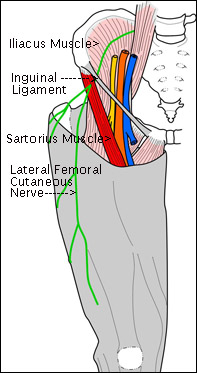Entrapment of the lateral femoral cutaneous nerve, diagnosed medically as Meralgia Paresthetica, has been poorly understood. Obesity, pregnancy, ill-fitting clothing are implicated, citing mechanical compression of the nerve as the cause. Treatment is conservative and usually takes several months to resolve. In a cursory search through the literature, only Travel and Simons in Myofascial Pain and Dysfunction, The Trigger Point Manual identify a different source on pages 230-233. This medical manual is the guidebook for the Neuromuscular Therapy treatments I use to treat difficult chronic pain complaints in my office near Boston.
 Nerve entrapment causing numbness and burning on the skin of the outer thigh can be caused by the sartorius and the iliacus muscles. The sartorius muscle attaches to the ASIS (anterior superior iliac spine) at the front angle of the hip bone and travels diagonally across the thigh to the inner knee. To find the ASIS, place your hands on your hips with fingers facing forward so you can feel the curved top of the bone (iliac crest) with your index fingers. Feel for the angled point at the front with your middle fingers. That’s the ASIS to which attaches the sartorius muscle and the inguinal ligament. The lateral femoral cutaneous (LFC) nerve runs just under that attachment point and can sometimes pierce the sartorius muscle as it exits the pelvis. Tension in the sartorius pulls on its tendonous attachment and narrows the space beneath it, trapping the nerve. If the nerve goes through the sartorius, it squeezes it. Either way, entrapment reduces or alters sensation and function causing numbness and weakness. If the nerve gets irritated it causes the burning sensation.
Nerve entrapment causing numbness and burning on the skin of the outer thigh can be caused by the sartorius and the iliacus muscles. The sartorius muscle attaches to the ASIS (anterior superior iliac spine) at the front angle of the hip bone and travels diagonally across the thigh to the inner knee. To find the ASIS, place your hands on your hips with fingers facing forward so you can feel the curved top of the bone (iliac crest) with your index fingers. Feel for the angled point at the front with your middle fingers. That’s the ASIS to which attaches the sartorius muscle and the inguinal ligament. The lateral femoral cutaneous (LFC) nerve runs just under that attachment point and can sometimes pierce the sartorius muscle as it exits the pelvis. Tension in the sartorius pulls on its tendonous attachment and narrows the space beneath it, trapping the nerve. If the nerve goes through the sartorius, it squeezes it. Either way, entrapment reduces or alters sensation and function causing numbness and weakness. If the nerve gets irritated it causes the burning sensation.
Treatment of the sartorius using Neuromuscular Therapy and Active Isolated Stretching techniques relaxes the muscle, taking the pressure off the nerve and reducing the activity of Trigger Points that cause pain at the inner thigh.
The next post is about the iliacus muscle and how it causes entrapment as it passes through the lacuna musculorum at the groin.